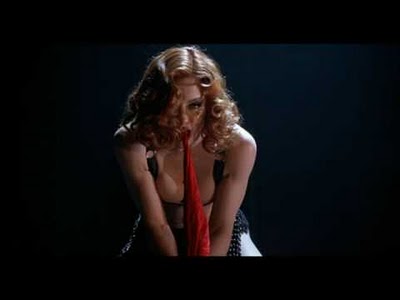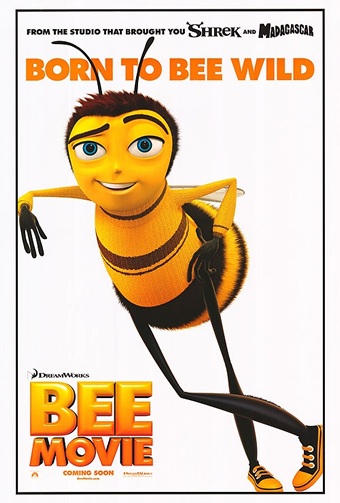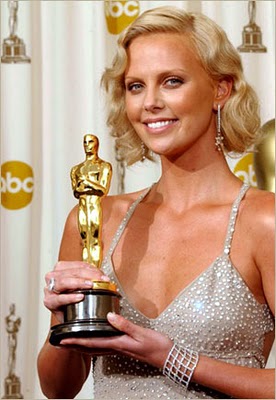 |
| Bee Movie (2007) |
This is a guest post from Nicola Mason.
While shopping one day recently, I happened upon and purchased Bee Movie, the 2007 animated film featuring characters voiced by Jerry Seinfeld and Renee Zellweger. I had taken up beekeeping a few months before—had a hive of some 10,000 bees in my backyard—and I’d been educating my four-year-old daughter on how a hive’s vast population of wee six-legged arthropods work together to produce that delightfully sweet amber end-product, honey. I thought Bee Movie would be the perfect mom-daughter flick, and that it would reinforce much of what my little girl had been learning over the course of our bee-centric summer. To my horror, the movie not only presented a slew of factual inaccuracies, it also imposed a decidedly male worldview on the most successful matriarchal society in nature.
The movie begins on the graduation day of young Barry B. Benson (Seinfeld), who, along with the rest of his class (including his best friend, Adam, voiced by Matthew Broderick), must choose a job within New Hive City. A tour guide takes the class—made up of male and female bees—through the bustling inner complex and describes the choices available as we view (largely male) bees hard at work in the Honex industry.
The problem here is that, in actuality, male bees don’t work in the hive. At all. There are only a few drones in any given bee population, and their only “job” is to meet at a designated outdoor spot every afternoon in the hope that a virgin queen will pass by so they can fertilize her in an insect-world version of a gang bang. When the queen returns to the hive, she is so well fertilized that she need never mate again. All the eggs she will lay within the course of her life are already primed with the necessary genetic material to make the burgeoning brood of daughters that is necessary for the group’s survival. I feel compelled to point out that drones are considered so . . . inessential . . . that when winter sets in, they are summarily forced out of the hive and blocked from re-entering. The workers don’t want to waste precious honey on them, since it takes on average 40 lbs of the sweet stuff to sustain a hive through the cold months until nectar flows again. Drones would be an unnecessary drain on resources—and the workers can easily make a new bevy of boy-toys in the spring.
Weirdly, Barry lives in a private residence inside the hive with both a mother and father bee. The mother stereotypically worries over him and scolds him: “Don’t fly in the house!” Later in the film, the fact that the queen is his “real” mother is made clear. The Bensons are his adoptive parents. It seems worth mentioning, however, that this most powerful female force—the queen bee—is never seen and rarely mentioned. In essence, her role, and her significance, are downplayed because the movie is centered on its male hero—Barry—who, unwilling to be simply subsumed by predestined bee duties, dreams of a life of adventure.
In search of this life, he fixates on the “pollen jocks,” an eponym the film pins on forager bees, which in actuality are, of course, female. Here is where the movie takes, to my mind, a flat-out appalling testosterony turn. Its foragers are depicted as a military battalion of super bees—much larger than the workers, uniformly male, their chests puffed out with muscle and, one gathers, masculine pride. They are referred to by their drill sergeant as “monsters” and “sky freaks” as they line up at “J Gate” for their daily mission while a throng of starry-eyed female bees giggle and wave and gasp admiringly nearby. Moreover, these jocks are equipped with “nectar packs” that they carry on their backs. When Barry joins them one day (on a dare), we discover these are collection devices that, held like guns, violently siphon nectar from the flowers without the bees even having to land. Barry looks on in wonder as nature is raped and laments that he was not bred to be a pollen jock. (Insert retching sound.)
As the moviegoer expects, Barry finds a way to make his own mark. He takes the forbidden path and communicates with a human—a ditzy female florist (Renee Zellweger), who then largely drops out of the film as Barry pursues his solo crusade to keep humans from “stealing” the honey that bees work so hard to produce. The scandal goes public, and Barry, interviewed by a bee version of Larry King, becomes famous. A lawsuit ensues (bee world and human world collide), Barry wins, yadda yadda. There is an additional plot twist that brings his florist crush—with her oh-so-feminine love of lots and lots of pretty flowers—back into play, but even my four-year-old had lost interest at this point, so I will not bore you with the details.
Clearly the movie was intended as a star vehicle for Seinfeld. Obviously a male conceived of the movie (David Moses Pimental is listed as Head of Story). The writers of the screenplay—all seven of them, including Seinfeld—are, big surprise, male. What they created was not just a fiction but a male fantasy. The human female is even lured away from her big hunky boyfriend by tiny-but-charming Barry. Sure, you can give the film credit for a cross-species romance, but how difficult would it have been to simply reverse these roles? How about a female bee nonconformist hero? A male florist who adores all things prettily petaled and whose greatest aspiration is to attend the annual flower festival/parade, manning his own float? Humor could still be the heart of the film, but a slant, surprising, and more fulfilling humor that arises from challenging culturally-ingrained gender expectations instead of reinforcing them—emphasis on the forcing. I would give my weight in honey to see a film like that.
Nicola Mason is the managing editor of The Cincinnati Review, a lit mag based at University of Cincinnati. Her fiction has been widely published and anthologized. She is also a visual artist:www.nicolamason.com.












